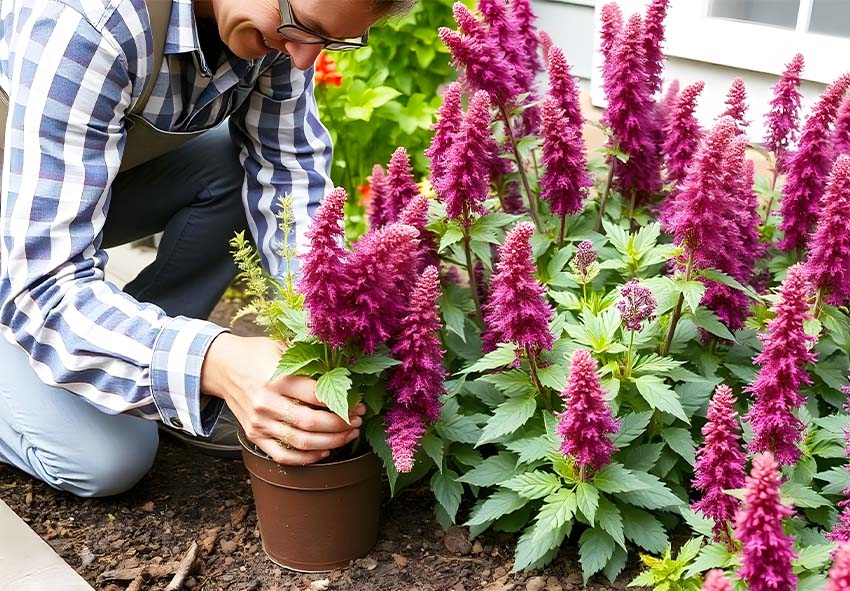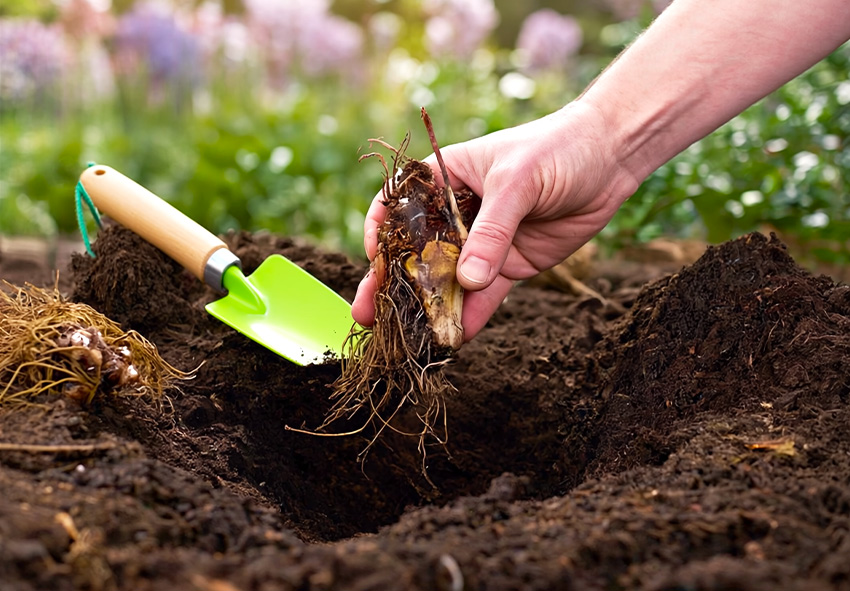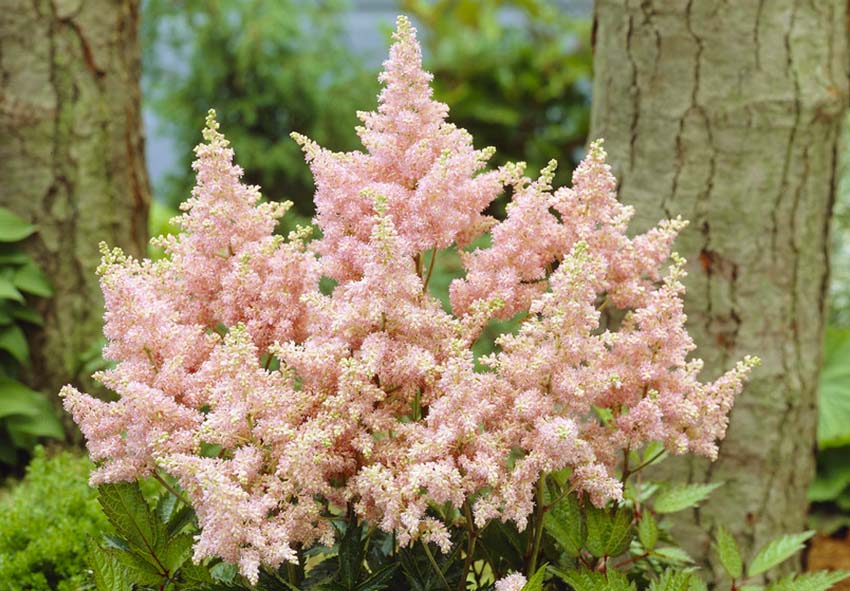Astilbe is a favorite among gardeners for its feathery plumes and ability to brighten up shady areas of the garden. Known for thriving where many other perennials struggle, this plant is both elegant and surprisingly low-maintenance once established. Learning how to plant Astilbe correctly ensures healthy roots, abundant blooms, and long-lasting beauty in your borders or woodland beds. Our gardening blog is a perfect place to find any information you need!
Choosing the Right Location

Astilbe’s success begins with choosing the right planting site. Since it loves cool, moist conditions, finding the right balance of shade, soil, and moisture is essential. Selecting the proper location will give your Astilbe rhizomes the best possible start.
Light Requirements for Astilbe
Astilbe grows best in partial shade, although it can tolerate full shade in hotter climates. Too much sun can cause the delicate foliage to scorch, while deep shade may reduce flowering. Planting Astilbe in shade or dappled sunlight creates the ideal balance for healthy growth and vibrant blooms.
Soil Preparation and Drainage Needs
The best soil for Astilbe is rich, humus-heavy, and consistently moist. Astilbe rhizomes cannot tolerate drought or overly dry soil, so incorporating compost or organic matter before planting is important. Good drainage also prevents root rot, ensuring the plant thrives for years to come.
Preparing Astilbe Rhizomes for Planting
Before putting Astilbe in the ground, proper preparation of the rhizomes is necessary. Taking the time to soak and handle them correctly will improve establishment and early growth. By preparing them carefully, you give your plants the strongest possible foundation.
Soaking and Pre-Planting Treatment
Astilbe rhizomes are often shipped dry, which means soaking them in lukewarm water for a few hours before planting helps rehydrate them. This step encourages quicker root development once planted in the soil. Skipping this can lead to slower growth and reduced vigor.
Timing the Planting Season
The best time to plant Astilbe is in spring or early fall when soil temperatures are moderate. Planting during these cooler seasons helps the rhizomes settle in without stress from summer heat. Avoid planting in midsummer, as the intense heat and dry soil may weaken new roots.
Step-by-Step Guide to Planting Astilbe

Planting Astilbe is a straightforward process once you understand the proper depth and spacing. Following these steps ensures your plants have the room and environment they need to flourish. Paying attention to details now will save you from issues later:
- Digging the Hole and Planting Depth: When planting Astilbe rhizomes, dig a hole about 4–6 inches deep and wide enough to spread the roots comfortably. The recommended Astilbe planting depth is just deep enough so that the top of the rhizome sits 1–2 inches below the soil surface. Space plants 12–18 inches apart to allow for good airflow and growth.
- Positioning the Rhizome: Astilbe rhizomes can sometimes be tricky to orient, but the buds or eyes should always face upward. If you’re unsure, planting the rhizome on its side ensures the plant will find its way up naturally. Correct positioning supports faster sprouting and healthier shoots.
- Backfilling and Watering: After placing the rhizome, backfill the hole with rich, moist soil, gently pressing it down to eliminate air pockets. Water thoroughly after planting to settle the soil around the roots. Consistent moisture during the first few weeks is crucial to establishing a strong root system.
Tips for Successful Astilbe Planting
Even though Astilbe is relatively easy to grow, a few extra steps can ensure greater success. Mulching, choosing companion plants, and avoiding common mistakes will make your planting experience much smoother. These small adjustments can have a big impact on your results.
Mulching for Moisture Retention
Adding a layer of organic mulch around your Astilbe helps keep the soil moist and cool. Mulch also suppresses weeds, which compete with young plants for water and nutrients. This simple practice supports healthier and more resilient growth.
Companion Plants to Consider
Astilbe pairs beautifully with hostas, ferns, and heucheras, all of which thrive in shade and moist soil. Combining these plants creates layered textures and varying heights that enhance the garden’s overall appeal. Companion planting also helps maintain consistent soil conditions around your Astilbe.
Common Planting Mistakes to Avoid
A frequent mistake is planting Astilbe rhizomes too deep or in soil that dries out quickly. Another common error is placing them in full sun, which leads to stress and reduced flowering. Avoiding these pitfalls ensures long-lasting, vibrant displays year after year.
Popular Varieties of Astilbe to Plant

Astilbe comes in a wide range of species and hybrids, making it a versatile choice for gardens. Each variety has unique bloom times, colors, and growth habits, allowing you to design a dynamic and textured landscape. Below are some of the most popular Astilbe varieties to consider for your shady beds and borders:
- Astilbe japonica – Known for early summer blooms and feathery plumes in shades of pink, red, and white. Compact growth makes it ideal for borders and smaller spaces.
- Astilbe chinensis – More tolerant of slightly drier conditions than other types, with late-season blooms that extend the garden’s color.
- Astilbe arendsii – A popular hybrid group with a wide range of colors and sizes, offering dramatic displays and excellent cut flowers.
- Astilbe simplicifolia – Features finely cut foliage and delicate plumes, perfect for adding texture to shaded garden beds.
- Astilbe thunbergii – Tall and graceful, with arching plumes that add movement and elegance to woodland gardens.
For a deeper look at different Astilbe varieties and planting tips, explore our complete guide to Astilbe.
Conclusion
Planting Astilbe is a rewarding process that brings lasting color and texture to shaded parts of the garden. By selecting the right site, preparing rhizomes carefully, and following proper planting depth and spacing, you set your plants up for success. With just a little attention to detail, your Astilbes will thrive and delight for years to come!
Frequently Asked Questions (FAQs) about Planting Astilbe
1. When is the best time to plant Astilbe?
The best time to plant Astilbe is in spring or early fall when temperatures are cool and soil moisture is stable. These conditions allow the roots to establish before extreme heat or frost. Planting during these seasons helps ensure strong growth and vibrant blooms in the following summer.
2. What type of soil is ideal for Astilbe?
Astilbe thrives in moist, well-drained soil rich in organic matter. A slightly acidic to neutral pH (6.0–7.0) is best for healthy root development. Amending soil with compost or leaf mold can improve fertility and water retention, helping the plant flourish in shaded or partially shaded areas.
3. Can I order Holland Astilbe from your online store?
Yes, you can! Our online store Dutch-bulbs.com offers a wide selection of Astilbe plants, including different varieties and colors. We take pride in providing top-quality plants that are carefully cultivated and shipped with care to ensure they reach you in perfect condition.
4. How should I water newly planted Astilbe?
Newly planted Astilbe requires consistent watering to establish roots. Keep the soil evenly moist, especially during dry spells, but avoid waterlogging. Once established, Astilbe remains water-loving and benefits from regular watering throughout the growing season.
5. Can I plant Astilbe with other perennials?
Yes, Astilbe pairs beautifully with shade-loving perennials like hostas, ferns, and heucheras. These companions share similar moisture and light requirements, creating a lush and balanced garden design. Combining Astilbe with other plants also adds variety in height, foliage texture and bloom color.
Published: 09.09.2025
